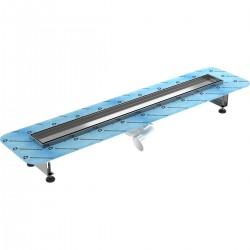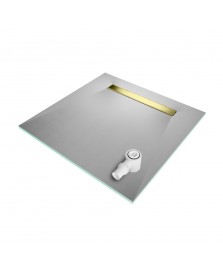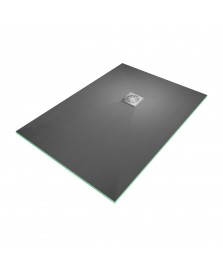- today
- perm_identity Chris Miller
- label Wet Room Kits
- favorite 0 likes
- remove_red_eye 2331 views

If you’re considering installing a wet room in your home, understanding how wet room drains function is key. Unlike a typical bathroom that has contained zones for wet areas like showers, a wet room allows water to spread over the entire floor space. This makes effective drainage essential.
Read on as we break down the fundamentals of wet room drainage so you can make informed design choices.
A Closer Look at Wet Rooms
Before we delve into wet room drains, it’s important to understand what exactly a wet room is.
Essentially, a wet room bathroom does away with screens and enclosures around showers and bathtubs. The whole room becomes one big ‘wet zone’, allowing water to cover the floor space.
The open, fluid design can make your bathroom feel larger and more airy, while the level access and easy-to-clean surfaces make it a practical choice for many households.
What Is a Wet Room Drain, and Why Is It Important?
The primary function of a wet room drain is to efficiently channel water away from the shower area and into the waste system. Without adequate drainage, water would simply pool everywhere, flooding adjoining rooms and causing extensive water damage.
Wet room drainage also:
-
Prevents slips and accidents caused by flooded floors
-
Allows the use of level-access shower trays for accessibility
-
Reduces moisture and potential mould issues
-
Requires less cleaning than contained showers
The Functioning of a Wet Room Drain
The proper functioning of a wet room drain depends on these components:
Floor Gradient
The operation of a wet room drain begins with the correct installation. The floor of the wet room is slightly sloped towards the drain, ensuring that water naturally flows in the right direction. This gradient is typically created during installation using a pre-formed shower tray or a screed floor.
Drains and Drain Placement
The drain usually spans the width of the shower area or is located in the centre of the shower area. However, it can also be placed in any other location where water accumulates. The placement of the drain is crucial as it affects the direction of the water flow.
Shower Traps
This waste pipe, called a shower trap, is connected to the main sewage system of the house, allowing the water to be safely and hygienically removed. The trap also holds a small amount of water, creating a seal that prevents sewer gases from entering the home through the drain.
Waterproofing
The wet room is waterproofed to prevent water from seeping into the underlying structure and causing damage. This process, also known as tanking, involves applying a waterproof membrane to the floor and walls of the wet room.
Types of Wet Room Drainage Systems
Choosing the right type and size of drain is crucial. The drain must be capable of handling the flow rate of the shower to prevent overflow. There are two main types of drains used in wet rooms:
Point Drains
Point drains, positioned centrally in the shower area, are the traditional choice. They drain water less efficiently in a spread-out wet room setting. Point drainage requires the floor to be sloped from all directions towards the drain.
Linear Drains
Linear drains, on the other hand, are a more contemporary choice. Also known as channel drains, linear drains are long and narrow and sit along one edge of the shower area. The floor only needs to be sloped in one direction towards the drain, making installation easier and allowing for a larger, uninterrupted tiling pattern.
Choosing the Best Drainage Solution
Getting drainage right is crucial for a functional wet room that stands the test of time. Several factors determine the most appropriate wet room drainage system, including:
-
Room size and layout: Larger spaces suit wider linear drains spanning entire floors, while tight spaces may rely on point drains.
-
Water volume: More water demands increased drainage capacity, so larger channels or multiple drains may be needed.
-
Floor construction: Concrete floors make installing new drainage straightforward, while timber substrates have extra considerations.
-
Floor levels: Completely flat floors allow ultra-low linear drains, while pre-existing floors with height variations may require other approaches.
Choose Wetroomstop for Superior Wet Room Drainage Solutions
Understanding the key elements of wet room drainage, from the necessity of a floor gradient ensuring water flows towards the drain, to the types of drains available, such as point and linear drains, is crucial for a functional and safe wet room.
At Wetroomstop, we specialise in supplying high-quality products for creating the ideal wet room in the UK, from wet room kits and waterproofing materials to efficient and stylish drainage solutions. Our linear drains offer durable functionality and a sleek, modern look to complement any bathroom.
Contact our expert team today for information or advice on product selection, installation, or maintenance.

















